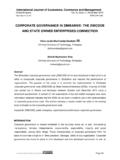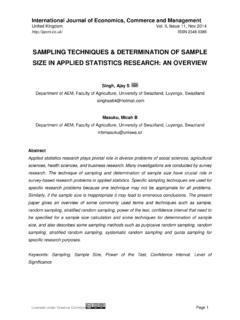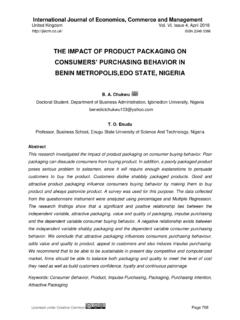Transcription of THE ONTOLOGICAL AND EPISTEMOLOGICAL FOUNDATIONS …
1 international Journal of Economics, Commerce and Management United Kingdom Vol. II, Issue 10, Oct 2014 Licensed under Creative Common Page 1 ISSN 2348 0386 THE ONTOLOGICAL AND EPISTEMOLOGICAL FOUNDATIONS OF QUALITATIVE AND QUANTITATIVE APPROACHES TO RESEARCH WITH PARTICULAR REFERENCE TO CONTENT AND DISCOURSE ANALYSIS OF TEXTBOOKS Dieronitou, Irene University of Nicosia in the field of Education Policy & Leadership, Cyprus Abstract The paper argues that CDA ( critical Discourse Analysis) provides an appropriate research framework for analyzing textbooks with regard to the identification of cultural depictions. By drawing some examples concerning the techniques used in textbook analysis, this paper has come to suggest that each technique reflects aspects of the three major paradigms such as positivism, critical theory and interpretivism.
2 This finding then drives us to reject the methodological distinctions raised by paradigmatic purists, and adopt instead a more hybrid approach to research methodology by supporting the notion that CA (Content Analysis) and CDA suggests a similar ONTOLOGICAL underpinning for quantitative and qualitative approaches. Succinctly, this study suggests that any quantitative approach is underpinned by qualitative considerations and vice versa. Keywords: qualitative and quantitative methodology, research paradigms, content analysis, critical discourse analysis, epistemology, ontology. Dieronitou Licensed under Creative Common Page 2 INTRODUCTION This paper aims to explore the EPISTEMOLOGICAL and ONTOLOGICAL issues concerning social research and their implications to the research of textbooks regarding cultural depictions.
3 My reason for focusing on content analysis and discourse analysis rests in the fact that both exhibit contrasting approaches to research stemming from the two major research paradigms, positivism and constructivism respectively. Another rationale that motivated my interest on these two research approaches lies in the absence and unsystematic use of discourse analysis or qualitative content analysis approaches to textbook research regarding the depiction of the other . The most commonly used approach is content analysis whereas researches hardly do they refer to epistemologically considerations. The failure by content analysts to examine the ONTOLOGICAL and EPISTEMOLOGICAL assumptions of their research process, leads content analysis to be viewed as a rigorous and rational method which adheres to the positivistic model.
4 I will allude further to this point in later sections. Although it is widely agreed that quantitative and qualitative research methods address different but complementary aspects of practices and thus they can be combined, it becomes necessary to probe beneath the surface of the technical level and adopt an approach which views both research paradigms as underpinned by all EPISTEMOLOGICAL and ONTOLOGICAL nuances. Therefore, the remainder of the paper builds on the assumption that every form of quantity to be established uses forms of quality and vice versa. If we think of geometry and literature as belonging to natural sciences and humanities respectively, we could may well scrutinize their EPISTEMOLOGICAL FOUNDATIONS beneath the scientific and humanistic divide.
5 This being the case, we may well argue that as the assignment of numbers in geometry requires qualitative observations in order to make inferences between the relationships of the angles of a triangle, likewise, metrics and prosody in a poem may well ascribe meaning to its content. The reason I make this point here is to set the scene for the arguments that will follow as to show that the philosophical distinctions between quantitative and qualitative content analysis or discourse analysis are blurring when a provisionalist epistemology is adopted for both approaches. Before proceeding to achieve this aim I deem as important to explore in detail the basic principles that underlie the epistemology and ontology of the three most debated competing paradigms.
6 Paradigmatic shifts and their implication in social research The aim of this section is to tackle the concepts of epistemology and ontology which underpin the three major competing paradigms (positivism, critical theory and interpretivism) and each of them will be scrutinized and applied accordingly to critical Discourse Analysis in later sections. international Journal of Economics, Commerce and Management, United Kingdom Licensed under Creative Common Page 3 Before going on to address the philosophical issues, I consider as important to note that commentators do not have a consistent way of referring to these paradigmatic approaches. For instance, Tashakkori and Teddlie (1998) refer to paradigms of logical positivism, post-positivism, pragmatism and constructivism while Guba (1990) dissociates positivism from the other three paradigms that have emerged as a challenge to it which are post-positivism, critical theory and constructivism.
7 Usher (1996) refers to positivism/empiricism, hermeneutic/interpretivism and critical theory whilst Bryman ( 2004) refers to positivism and interpetivism and distinguishes the later from its variants known as phenomenology, hermeneutics and symbolic interactionism. The most recent research paradigm put forward by many theorists and practitioners in order to overcome the paradigmatic schism is pragmatism . Advocates of the so-called pragmatic approach to research have over emphasized its practicability in combining diverse research methods while underestimating the importance of philosophy for social and educational inquiry ( Tashakkori and Teddlie, 1998). The term paradigm in its most generic sense has philosophical connotations for many researchers.
8 The contention of this paper is that since almost all researchers whether they ascribe to the positivist, constructivist or pragmatic tradition, adopt the conventional term paradigm to offer a new range of opportunities to research, the role of epistemology and ontology becomes vital. Not surprisingly, most commentators employ a common reference point when defining paradigms . Schwand (1989) defined paradigms as worldviews and beliefs about the nature or reality, knowledge and values. Similarly Guba and Nincoln (1994) referred to paradigms as worldviews or belief systems that guide researchers. Vedeler (2000) by describing paradigms as theoretical frames , contends that philosophical considerations precede determining the choice of methods and therefore offer a better understanding of advantages and disadvantages of quantitative and qualitative approaches.
9 A different view of paradigm is set forth by Morgan(2007) who eliminates the essential role of epistemology for social inquiry by rejecting the EPISTEMOLOGICAL stance version of paradigms and adopting instead an alternative approach, the aforementioned pragmatism which is grounded on the notion of what works , the accordance of fitness to purpose and the like. From all the attempts to define paradigm it follows that the social inquiry involves methodology-as technique and methodology as- philosophy . According to Hammersley (2006) the former depicts research as the involvement of particular methods or procedures, those that fall within the category of natural sciences and are distinguished from humanistic disciplines, while the latter concerns fundamental questions about the goal of knowledge of research, the ideal of truth and the possibility of objectivity.
10 Dieronitou Licensed under Creative Common Page 4 Although Hammersley views the role of philosophy as essential to research, he argues that there are important limits to its contribution for it does not enlighten researchers how best to go about investigating particular topics. In contrast, there are those who advocate a top-down approach to research arguing that ONTOLOGICAL assumptions give rise to EPISTEMOLOGICAL ones, which in turn determine the unfolding of methodology which gives rise to issues of instrumentation and data collection (Hitchcock and Huges, 1995; Guba, 1990). Before the discussion is pursued on exploring the basic attributes of the three major paradigms, two important concepts need to be tackled, ontology and epistemology. Ontology traces its meaning from the ancient Greek present participle /on/ which means to exist.









